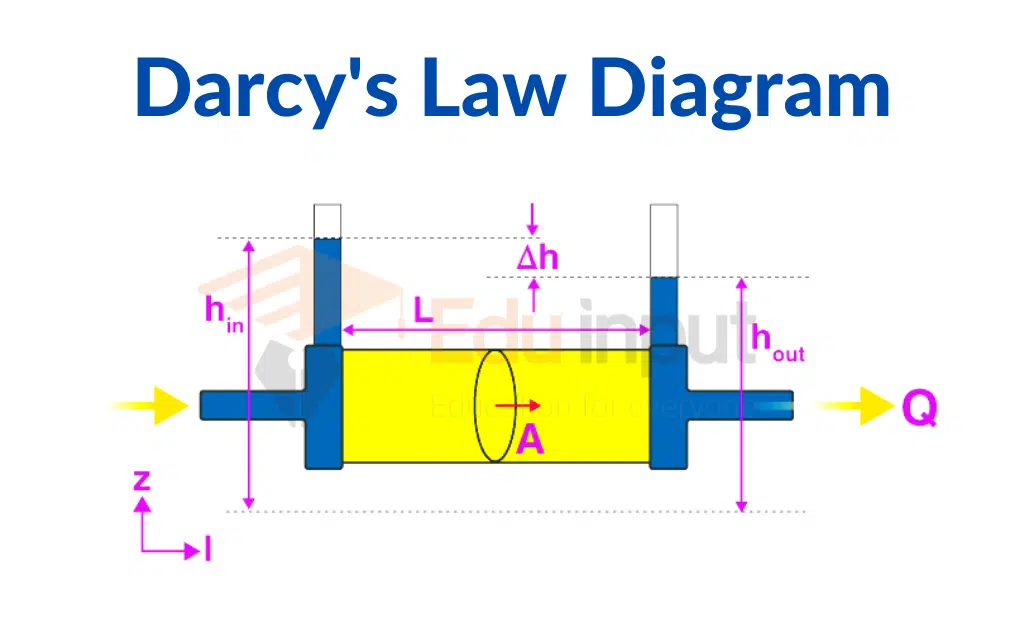Darcy’s Law-Definition, Formula, Uses, And Limitations
The law that describes how fluid flows through a porous medium is called “Darcy’s Law”. Experiments carried out on the flow of water through beds of sand led to the creation of the Law of Darcy.
It is a branch of geology and the basis for hydrology. It is similar to Ohm’s Law in that it relates the volume flow rate to the pressure difference in the fluid.
Darcy’s Law History
Darcy’s law, which was first discovered experimentally by Darcy, is now derived from the Navier-Stokes equations via homogenization methods.
It is similar to the law of heat conduction, the law of electrical networks, and the law of diffusion theory. One of the basic relationships of hydrogeology is the analysis of water flow through an aquifer, and one of the applications of Darcy’s law is in that.
The equation for a single-phase flow was refined by Morris Muskat. Less viscous fluids have less difficulty permeating through a porous medium. It was suitable for researchers in the industry.
In order to cover a multiphase flow of water, oil, and gas in a porous medium, Muskat and Meres generalized the law. The analytical foundation that exists to this day is provided by the generalized multiphase flow equations.
Darcy’s law Equation
The mathematical aspects of liquid flow in the substance can be described as:


This is a relationship between the instantaneous rate of discharge through a porous medium and pressure drop at a distance.
Uses of Darcy’s law
A one-dimensional, homogeneous rock formation with a single fluid phase and constant fluid viscosity is the most simple of the many derivations of Darcy’s law used in petroleum engineering.
Water zones under the oil legs and gas caps over the oil legs are some of the features that make up most of the oil reservoirs. A drop in oil production causes the oil zone to flood, and the oil zone gets mixed with water.
If you want to keep your wells producing, you might need to inject water into the well as part of your normal drilling and maintenance procedure.
There’s more than one phase in a multiphase fluid. The multiphase flow equation was developed by Muskat et alios and is being used by the petroleum industry.
The multiphase flow equation is referred to as Darcy’s law. There are many articles about multiphase flow in the oil and gas industry. One of them is called “Darcy’s Law for Multiphase Flow.
Limitation of Darcy’s Law
There are some conditions where darcy’s law is not applicable:
- Steady flow
- Transient flow
- Saturated flow
- Unsaturated flow
- Flow in granular media
- Flow in homogenous and heterogeneous systems
Related FAQs
What is Darcy’s law?
The principle which governs the movement of fluid in the given substance is stated by the law. The ability of the liquid to flow through porous media like a rock is described in a law equation by Darcy. The law is based on the fact that the flow between two points is directly proportional to the pressure differences between the points, the distance, and the connectivity of flow within rocks.
When was Darcy’s Law Invented?
The law of Darcy’s mathematical relationship was discovered in 1856 by the French engineer Henri Darcy, who found that the flow of water through the media of limestone is governed by the law.
What are the limitations of darcy’s law?
The law of Darcy’s, which was established in certain conditions, is laminar flow in saturated media, granular under steady-state flow conditions, which is considering the fluid homogeneous isotherm and is also neglecting the energy, which is kinetic.
Why is Darcy’s law important?
The movement of fluids through a porous media is described by the law of Darcy’s Law. It is one of the most important principles in the study of oil and gas formations and is used in calculations for the estimation of oil and gas recovery volumes.







Leave a Reply